Enjoy a hassle-free cup of chai (tea) with this simple recipe. Put it all together at once and let the magic begin.

My day starts with a cup of chai. Yes, many of you may know it as chai tea or chai milk tea, but in India, ‘chai’ is the Hindi word for tea. So when we say ‘chai tea,’ we are essentially saying ‘tea tea.’ In India, it’s simply called ‘chai.’
While many people love masala chai, I am more at the beginning of the spectrum and prefer just plain chai (tea). I do like masala chai and other variations, but plain chai tea is my go-to.
What is plain chai tea?
It’s just tea, sugar, water, and milk, with no masala added to this recipe. More than a recipe, it’s the method I use to make a cup of tea in the morning—the easy way—when I have ten other things to do.
For a long time, I thought the longer I simmered the tea leaves, the better it would taste. But I was so wrong. It’s not just the tea leaves. Chai is a love bond between tea leaves and milk, so the longer the tea leaves and milk cook together, the stronger the flavor will get. Also, a quick boil does not work as well. A slow cook at a low heat setting is what brings them together.
Ingredients
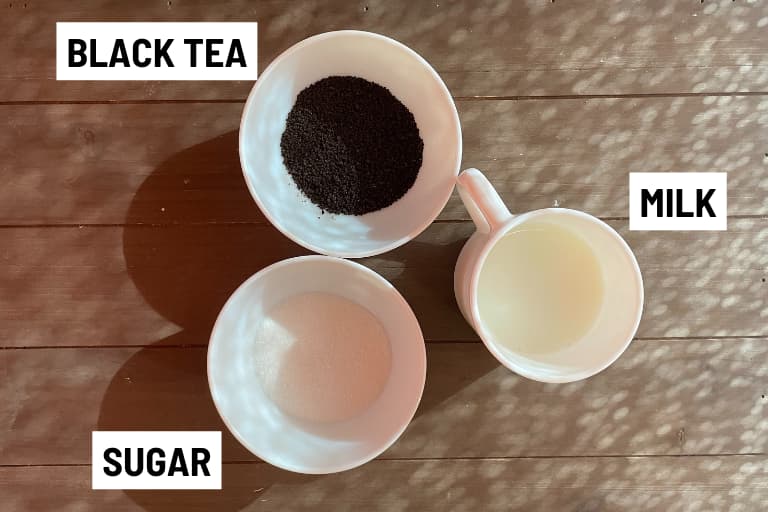
- Water
- Loose black tea leaves or tea bags: I prefer strong tea leaves from brands like Taj Mahal or Wagh Bakri, which you can easily find in any Indian grocery store, on Amazon, or at Walmart. Tea bags are also an option; I prefer Taj Mahal tea bags for their strong flavor, but you can use any brand you like. However, be aware that some brands may not have as strong flavors. I add 1.5 teaspoons of loose tea for each cup, and 1 or 2 tea bags per cup, depending on the brand.
- Milk (can be skim, 2%, or full fat): You can use skim milk or milk with fat, but be sure to adjust the ratio of water to milk depending on the type of milk. For skim milk, I use a 1:1 ratio, meaning I use an equal amount of water and milk. For 2% milk, I use a 2:1 ratio, and for full-fat milk, I use a 2.5-3:1 ratio.
- Sugar or honey: For taste (optional)
Note: Make sure to add extra liquid (around ¼ cup extra per cup of tea). See the recipe notes for examples.
Equipment
- Saucepan (medium-size): Any saucepan will work, steel or nonstick. Make sure the base of the steel saucepan is heavy and not too thin, as the milk can sometimes stick to the bottom and give a burnt taste.
- Strainer
Step-by-step instructions
1. Get everything together
Take your saucepan or pot, and add milk, water, and tea to it.
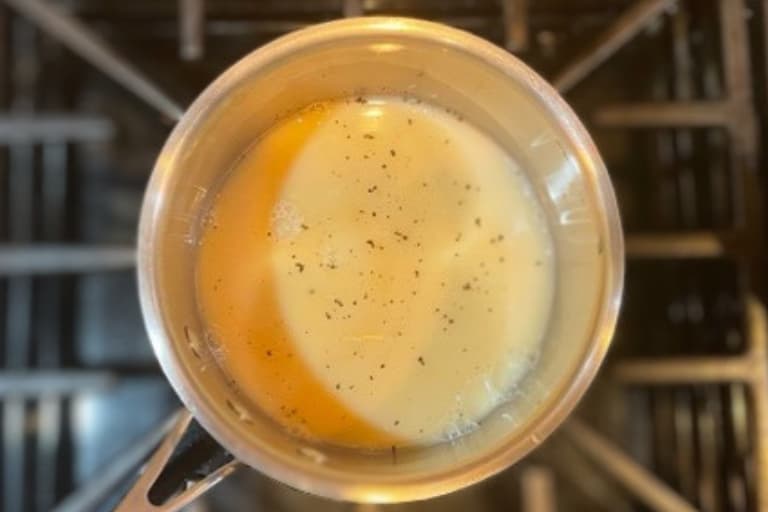
2. Get the first rolling boil
Place your pot on high heat and let it get to the first rolling boil. It may take a few minutes depending on the quantity you are making.
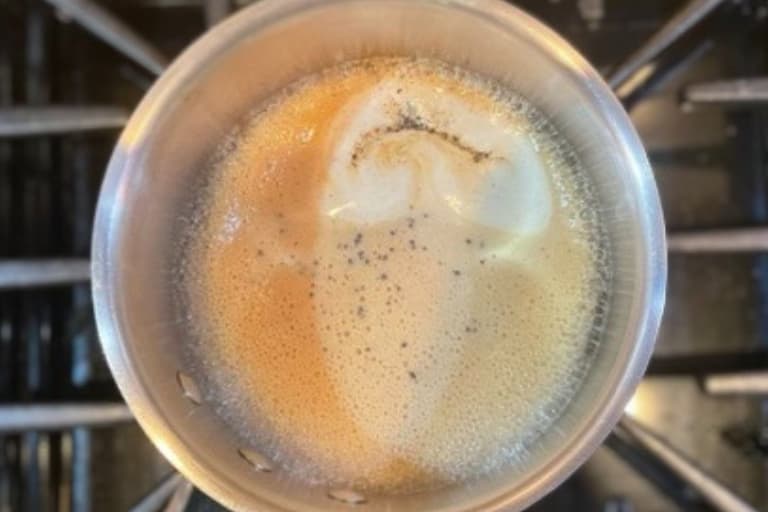
3. Simmer and Steep
At the first rolling boil, let it rise until close to the top, then turn the heat to low and let your tea simmer for 8 minutes. (I usually check the time at this point and then carry on with the rest of my work without worrying about my tea. You can also set an alarm for the 8-minute mark).
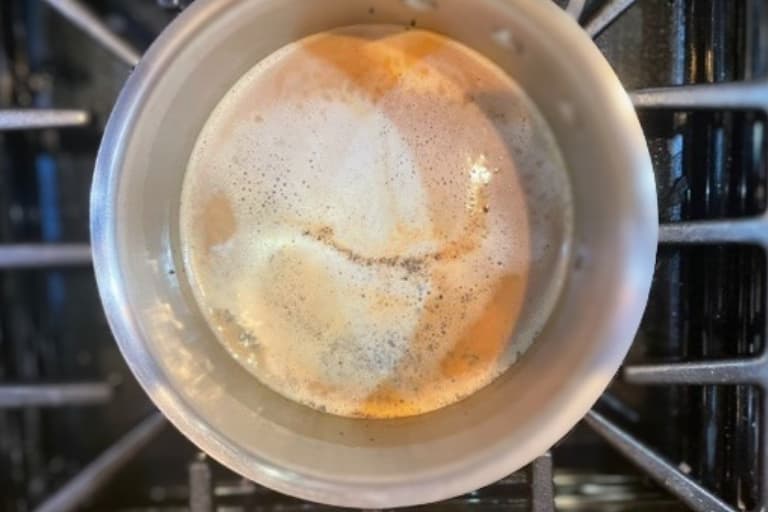
4. Final full boil
After 8 minutes of simmering, turn the heat to full and bring it to a full boil, then turn it off.
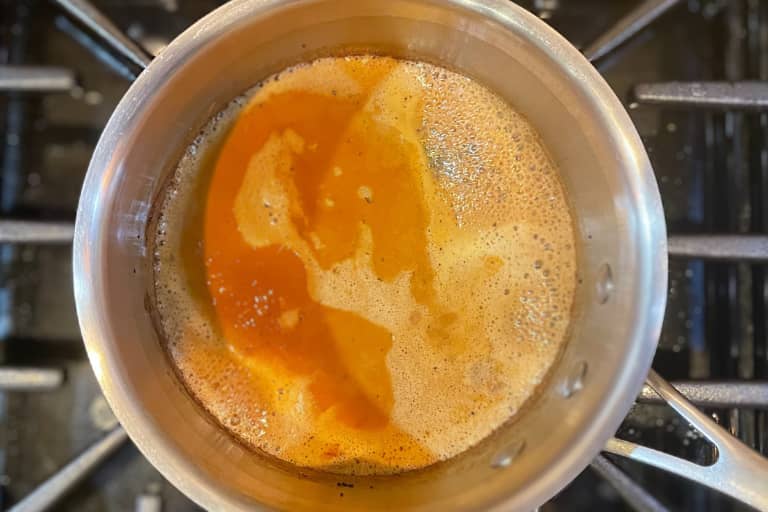
5. Optional: For more strength
If you are used to drinking Indian tea and want a stronger flavor, after the final boil, simmer on low heat for 2 minutes and then turn the heat off.
Still not strong enough? Increase the amount of tea by half a teaspoon per cup.
6. Strain
Use a strainer to pour the tea into cups. If your saucepan does not have a pouring spout, make sure to place a cloth under your tea cups to catch any tea spillage.
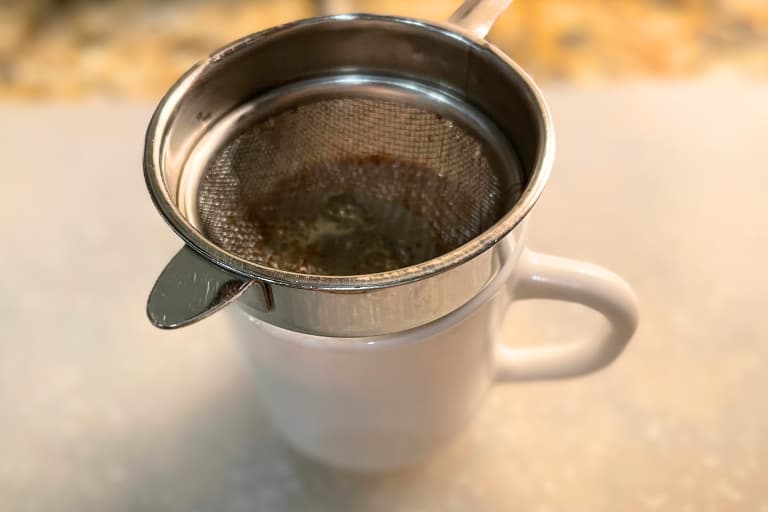
7. Optional: Aerate
Do you prefer some frothiness on top of your tea? Then strain your tea into another container, like a jug, and pour it into your cup from a height of about a foot. You will see some frothiness. By the way, this process is called aeration and is commonly used at tea stands and dhabas in India.
8. Enjoy and relax
Your chai tea is ready. Add some sugar or honey if you wish.
Care for some sweets? Well, go ahead and dunk some cookies to enjoy with your chai tea.
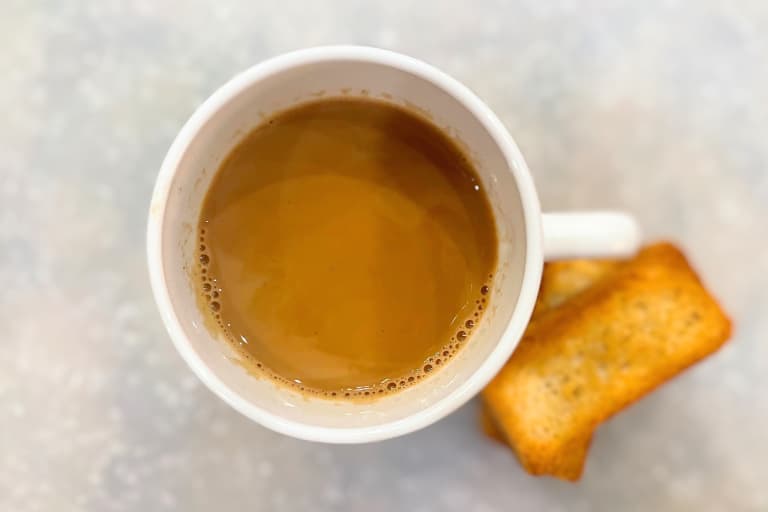
Can you use this method to make masala tea?
Yes, you can use this method to make masala chai. However, I prefer to let the spices simmer in water before adding tea and milk.
Also, do not use this method for any tea variation that includes ginger. Ginger contains a protease called ‘zingipain,’ which can denature the proteins in milk. Therefore, ginger should be boiled in water first. So, if you want to add ginger, do so during the time of the first boil or consider avoiding it altogether.
Substitutions
Make it vegan
You can substitute regular milk with vegan options such as almond milk or oat milk. Almond milk is generally lighter than oat milk, so adjust your ratio accordingly; I usually use 1.5 to 2 parts almond milk to 1 part water.
If you’re using these substitutions, the method will change slightly. Do not add the milk at the start. Instead, warm it separately.
Follow steps 1 and 2 without any milk and you don’t need to bring tea leaves and water mixture to a rolling boil, you can simmer once you see that the water at the sides/edges of the saucepan has started boiling.
In step 3, when simmering for 8 minutes, add the warm milk at the 5-minute mark and let it simmer with the tea for 3 minutes. Avoid bringing it to a boil. In my experience, the taste of almond milk tea changes when boiled. I haven’t used oat milk extensively, so as a precaution, I also recommend not boiling it with the tea.
Make with tea bags
If you don’t have loose tea leaves, you can use tea bags. Use 1-2 tea bags for every cup of chai tea. Also, when removing the tea bags, don’t forget to squeeze them to extract more tea and flavor from the bags.
Storage
I do not recommend storing chai tea for a long time, as the taste tends to get altered. If necessary, you can store it in an insulated bottle or container, like a thermos, for up to 3 hours.
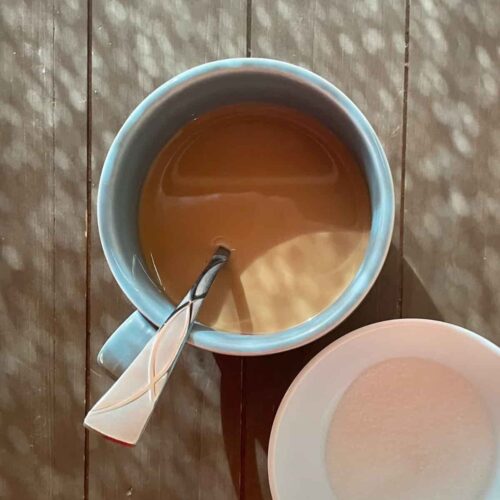
Easy Plain Chai (Tea)
Ingredients
For chai tea with skim milk
- 3 teaspoons loose black tea (3-4 tea bags depending on the brand)
- 1¼ cup skim milk
- 1¼ cup water
- 2-3 teaspoons sugar or honey (per your taste)
For chai tea with 2% milk
- 3 teaspoons loose black tea (3-4 tea bags depending on the brand)
- 1 cup 2% milk
- 1½ cup water
- 2-3 teaspoons sugar or honey (per your taste)
For chai tea with full-fat milk
- 3 teaspoons loose black tea (3-4 tea bags depending on the brand)
- ¾ cup full-fat milk
- 1¾ cup water
- 2-3 teaspoons sugar or honey (per your taste)
Equipment
- Saucepan medium
- Strainer
Instructions
- Get everything together: Add milk, water, and tea (loose tea or tea bags) to your saucepan.
- Get the first rolling boil: Place your pot on high heat. Let it come to a boil.
- Simmer on low: After it comes close to the top, put on low heat and let your chai tea simmer for 8 minutes.
- Final boil: After 8 minutes, turn the heat to full and let the chai come to a full boil and then turn off.
- Optional: For more strength, after the final boil, let the tea simmer at low heat for 2-3 minutes and then turn off.
- Strain: Use a strainer and pour the tea into your cups. If using tea bags, take them out with a spoon and place them on the strainer. Press with the spoon to get extra flavor.
- Enjoy your tea: Your tea is ready. Add sweetener if you wish. (I usually add 1-1½ tsp of sugar per cup).
Alternate method: To make vegan chai tea
- Get your saucepan: Add water and tea (loose tea or tea bags) to your saucepan.
- Get the first boil: Place your pot on high heat and let it come to a boil. You don't need a rolling boil; just when you see the mixture start boiling near the sides of the saucepan, that is enough.
- Simmer and steep: Lower the heat and let your chai simmer for 5 minutes.
- Prepare your vegan milk option: Warm your milk separately.
- Add milk: At 5 minutes of low heat simmer, add your milk to the tea, and simmer on low for an additional 3 minutes. (Do not bring to a boil)
- Strain: Use a strainer and pour the tea into your cups. If using tea bags, take them out with a spoon and place them on the strainer. Press with the spoon to get extra flavor.
- All done!! Your tea is ready, add any sweetener as per your taste.
Notes
2. Amount of tea: I use 1.5 teaspoons of loose black tea per cup or 1 to 2 tea bags per cup. (I do not take into account the extra fluid I add to compensate for evaporation. For example, if I am making 2 cups, I will still use 3 teaspoons of tea, even though I will add 1¼ cups of water and 1¼ cups of milk.) 3. Water to milk ratio: You can use a ratio of water to milk ranging from 1:1 to 3:1, depending on the type of milk. Use a 1:1 ratio for skim milk and a higher ratio for milk with fat, like 2:1 for 2% milk and 3:1 for full-fat milk. 4. Avoid the use of ginger with this method: Ginger contains a protease called “zingipain” which can denature the protein in milk. Therefore, if you want to add ginger, do so during the time of the first boil, or avoid using ginger altogether. 5. Aeration: If you prefer some bubbles or frothiness on top of your tea, strain the tea into a separate container like a glass or a jug. Then pour it back into your cup from a height, ideally a foot or more. This process is called aeration and helps to introduce air into the tea, creating a frothy texture. 6. Saucepan: It’s best to use a saucepan with a heavy base or a non-stick coating. This helps to prevent the milk from sticking to the bottom of the pan which can lead to a burnt taste. In my experience, milk is more likely to burn in a thin steel saucepan, especially when used on an electric cooking station. Also, if you make tea frequently, choosing a saucepan with a spout can minimize the chances of spillage. 7. Storage: Chai tastes best when made fresh. You can store it in a thermos or an insulated container for up to 3 hours, but I do not recommend storing it for any longer. 8. Nutritional information: The calculated nutrition facts below are for 1 cup of tea made with skim milk and without any sugar or any other substitute.
Nutrition
Nutrition information is calculated automatically and should be used only as an approximation.
Read our full nutrition disclosure